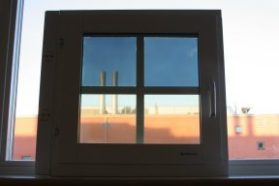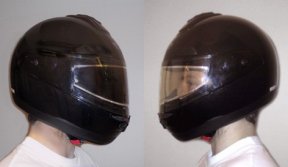Smart Windows
High-tech windows can change from clear to dark and back again at the touch of a button.
By Emily Sohn
A window is more than just an opening that you can see through. It can affect the way a building looks, how much energy a building uses—and even how you feel.
 |
|
Windows affect the way a building looks and how much sunlight gets in during the day. |
| I. Peterson |
Researchers are now working on new technologies to create “smart windows.” Unlike normal windows, high-tech smart windows can change from clear to dark and back again with the touch of a button—or even automatically as the outside light changes.
Smart windows have the potential to make the world a cleaner and more comfortable place. Instead of turning on air conditioners, people could simply dim the windows in a building’s empty rooms. The rooms would stay cool, and people would save energy and money at the same time.
That’s why smart windows are so exciting, says Claes Granqvist. He’s a professor of solid-state physics at Uppsala University in Sweden.
Indoor life
If you think that you don’t care much about windows, you should think again, Granqvist says.
Most people who live in developed countries spend, on average, 90 percent of their time inside buildings and cars. You might spend even more time than that indoors during the winter if you live in a cold climate.
 |
|
Being able to see out a window can help cheer you up, even if you’re ill. |
Imagine then what it would be like if there were no windows. You’d have no idea what’s going on outside.
“It took us a long time to figure out what a window really is,” Granqvist says. “It’s contact with the outside world. You have to have visual contact with the surrounding world to feel well.”
So, windows and natural light are important for improving the way people feel when they’re stuck indoors.
Yet, windows are the weak link in a building when it comes to energy and temperature control. In the winter, cold air leaks in. When it’s hot and sunny, sunlight streams in. All of this sunlight carries lots of heat and energy. And all of this extra heat forces people to turn on their air conditioners.
Producing blasts of cold air, which can feel so refreshing, actually suck up enormous amounts of electricity in buildings around the world. Most electricity comes from coal-burning and nuclear power plants. These energy sources generate carbon dioxide and pollutants or produce radioactive waste. And a growing population demands more energy.
 |
|
It would be more energy efficient to have buildings without windows, but windows are important for how buildings look and how people feel inside them. |
| I. Peterson |
“It would be very energy efficient to have a house with no windows,” Granqvist says, “but we don’t want that.”
Color changes
Windows have been a major focus of energy research for a long time. Over the years, scientists have come up with a variety of strategies for coating, glazing, and layering windows to make them more energy efficient.
Smart windows go a step further. They belong to a group of technologies described as chromogenic. Chromogenic technologies involve changes of color.
 |
|
Smart windows use electricity to change from dark to clear and back again. |
| Courtesy of Claes Granqvist |
Electrochromic windows use electricity to change color. For example, a sheet of glass coated with thin layers of chemical compounds such as tungsten oxide works a bit like a battery. Tungsten oxide is clear when an electric charge is applied and dark when the charge is removed. So, applying a voltage determines whether the window looks clear or dark.
One important feature that makes a smart window so smart is that it has a sort of “memory.” All it takes is a small jolt of voltage to turn the window from one state to the other. Then, it stays that way. Transitions take anywhere from 10 seconds to a few minutes, depending on the size of the window.
The amount of electricity required to power a smart window is so small, Granqvist says, that it should be possible to run it completely on solar power.
“It takes very, very little energy to change it back and forth,” he says. “It’s totally insignificant compared with the amount of energy you save from overheating and over-air-conditioning.”
 |
|
It doesn’t take much electricity to make certain panes of a smart window darker. |
| Courtesy of Claes Granqvist |
A wireless control system would make it easy to program a building to be dark when no one’s there. Or, people could darken an individual window when they’re sitting at the computer, or when they’re going out of town for a while.
“There’s no reason to have transparent windows,” Granqvist says, “when there’s no one to look through them.”
Dark market
Some companies already have test versions of smart windows on the market. Still, the industry faces some major obstacles before the technology becomes truly widespread.
“There’s still a ways to go,” says Carl Lampert. He’s managing director of Star Science, a consulting company in Santa Clara, Calif. “The manufacturing is complicated.”
For one thing, smart windows simply haven’t been around long enough for people to trust that they’ll work well and last for a long time. At this point, making smart windows is also an extremely expensive process, thanks to the complexity of the machines needed to apply coatings.
To turn people on to smart windows, Granqvist wants to start small by selling the technology to people who have special needs. Right now, he’s working on motorcycle and ski helmets with facemasks that could easily switch between dark and clear.
 |
|
This experimental helmet has a facemask that can switch between dark and clear. |
| Courtesy of Claes Granqvist |
Once these products catch on, it’s only a matter of time before our office buildings, schools, even houses are full of smart windows. “I think it’s definitely going to catch on,” Lampert says. “People are really excited about this.”
Smart windows could literally change the way we see the world, Granqvist says. It’s already happened to him.
“I travel quite a bit all over the world—to Singapore, Hong Kong, China,” he says. “When I began working on smart windows, I started to see air-conditioning systems everywhere. Buildings, even nice old buildings, were covered in ugly air-conditioning units.”
The development of smart windows could mean that massive air-conditioning systems may no longer be needed. “In the future,” Granqvist says, “our buildings may look different.”
Going Deeper:







